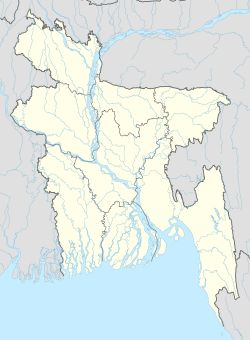world.wikisort.org - Bangladesh
Barhatta (Bengali: বারহাট্টা) is an upazila of Netrokona District, located in Bangladesh's Mymensingh Division.[1]
This article needs additional citations for verification. (October 2020) |
Barhatta
বারহাট্টা | |
|---|---|
Upazila | |
 Barhatta Location in Bangladesh | |
| Coordinates: 24°54′N 90°52.5′E | |
| Country | |
| Division | Mymensingh Division |
| District | Netrokona District |
| Government | |
| • MP (Netrokona-2) | Ashraf Ali Khan Khasru |
| • Upazila Chairman | Muhammad Mynul Hoque Kashem |
| Area | |
| • Total | 221.5 km2 (85.5 sq mi) |
| Population (2011) | |
| • Total | 180,449 |
| • Density | 810/km2 (2,100/sq mi) |
| Time zone | UTC+6 (BST) |
| Website | http://barhatta.netrokona.gov.bd/ |
History
The area that is now known today as Barhatta was a part of the Mughal Empire in the seventeenth century. One example of a remnant from this historical period includes an old Mughal building in Saudpur which is currently in dilapidated condition. In 1763, many members of the anti-colonial Pagal Panthi movement, led by Tipu Shah, stationed themselves in different areas around modern-day Barhatta. They set up a central barracks near a village named Borohati/Boruhati/Bouhati. The British troops, in search of a safe haven, founded Brahatta, another village in imitation of Barohati's name, which facilitated river communication. Although Brahatta is now known as Barhatta, the nameplate of the Barhatta railway station bears the memory of the previous name, Brahatta. This village is currently adjacent to Barhatta bazaar. On 15 June 1906, the Eastern Bengal and Assam government issued gazette 6676J which notified the establishment of a thana in Barhatta; whose construction was funded by Radhanath Kar Gang. In 1914, the Barhatta CKP High School was opened. Maulvi Tahjibuddin Ahmad was made the Sub-Registrar of Bhaluka on 4 August 1927, replacing Maulvi Abdul Wahed Ahmad.[2]
During the Bangladesh Liberation War of 1971, the Mukti Bahini launched a surprise attack on the police station in Mohanganj, causing the Pakistan Army to retreat towards Barhatta. The freedom fighters of Barhatta blew up the Thakurkona Railway Bridge in western Barhatta which disrupted the Pakistan Army from entering. Near the end of the war, a brawl took place in the Barhatta Police Station, leading to the death of civilians. Barhatta was liberated on 8 December 1971. The road from Barhatta to Chandrapur was renamed to Shahid Muqshid Mian Road in honour of Muqshid Mian, a Bengali Muslim freedom fighter who died in the war. In 1983, the thana was upgraded to an upazila (sub-district).
In 2009, BAPEX conducted two-dimensional seismic surveys, discovering a gas field now known as the Sunetra Gas Field.
Geography
Barhatta is located at 24.9000°N 90.8750°E and located on the banks of the Kangsha River close to the haor areas. Barhatta Upazila has an area of 221.50 km2 It is bounded by Kalmakanda and Dharamapasha in the north, Atpara and Mohanganj to the south and Netrokona Sadar to its west.
Demographics
According to 2011 Bangladesh census, Barhatta had a population of 180,449. Males constituted 50.19% of the population and females 49.81%. Muslims formed 89.32% of the population, Hindus 10.65%, Christians 0.01%, and others 0.02%. Barhatta had a literacy rate of 37.55% for the population 7 years and above.[3]
As of the 1991 Bangladesh census, Barhatta has a population of 142,174. Males constitute 51.42% of the population, and females 48.58%. This Upazila's eighteen up population is 71,214. Barhatta has an average literacy rate of 23.8% (7+ years); the national average is 32.4% literacy.[4]
Administration
Barhatta Upazila is divided into seven union parishads: Asma, Barhatta, Baushi, Roypur, Sahata, and Singdha. The union parishads are subdivided into 147 mauzas and 239 villages.[5]
Upazila chairmen
| Name | Term |
|---|---|
| Abd al-Qadir Khan | 1985 - 1990 |
| Mustafizur Rahman Khan Rizvi | 1990 - 1991 |
| Muhammad Mynul Hoque Kashem | Present |
Tourism
In addition to the old Mughal buildings in Saudpur and Amghail Court Bari, there is also an ancient twin-pond in the village of Amghail-Pirijpur.[6] There are also the mausoleums of Sohag Pir in Kailati and Nazar Ali Faqir in Premnagar.
Notable people
- Md. Innas Ali, Physicist
- Nirmalendu Goon, Poet
See also
- Upazilas of Bangladesh
- Divisions of Bangladesh
References
- Muhammad Abdus Shahid (2012). "Barhatta Upazila". In Islam, Sirajul; Miah, Sajahan; Khanam, Mahfuza; Ahmed, Sabbir (eds.). Banglapedia: the National Encyclopedia of Bangladesh (Online ed.). Dhaka, Bangladesh: Banglapedia Trust, Asiatic Society of Bangladesh. ISBN 984-32-0576-6. OCLC 52727562. Retrieved 9 September 2022.
- "445-456". Calcutta Gazette. 11 August 1927. p. 1664.
- "Bangladesh Population and Housing Census 2011: Zila Report – Netrakona" (PDF). Table P01 : Household and Population by Sex and Residence, Table P05 : Population by Religion, Age group and Residence, Table P09 : Literacy of Population 7 Years & Above by Religion, Sex and Residence. Bangladesh Bureau of Statistics (BBS), Ministry of Planning, Government of the People’s Republic of Bangladesh. Retrieved 14 December 2018.
- "Population Census Wing, BBS". Archived from the original on 27 March 2005. Retrieved 10 November 2006.
- "District Statistics 2011: Netrokona" (PDF). Bangladesh Bureau of Statistics. Archived from the original (PDF) on 13 November 2014. Retrieved 14 July 2014.
- উপজেলার ঐতিহ্য. Barhatta Upazila (in Bengali).
На других языках
- [en] Barhatta Upazila
[ru] Бархатта (подокруг)
Бархатта (бенг. বারহাট্টা, англ. Barhatta) — подокруг на северо-востоке Бангладеш в составе округа Нетрокона. Образован в 1905 году. Административный центр — город Бархатта. Площадь подокруга — 221,50 км². По данным переписи 1991 года численность населения подокруга составляла 142 174 человека. Плотность населения равнялась 642 чел. на 1 км². Уровень грамотности населения составлял 23,8 %. Религиозный состав: мусульмане — 86,30 %, индуисты — 13,45 %, христиане — 0,02 %, прочие — 0,15 %.Другой контент может иметь иную лицензию. Перед использованием материалов сайта WikiSort.org внимательно изучите правила лицензирования конкретных элементов наполнения сайта.
WikiSort.org - проект по пересортировке и дополнению контента Википедии
